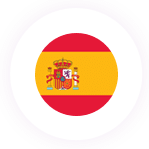The Iberian Peninsula, the birthplace of Spanish, Portuguese, Catalonian and Basque names, has an immensely colorful and rich history. We can’t help but to say it’s one of our favorites. The Greeks discovered the peninsula circa the sixth century B.C. The Romans encountered the people of Iberia during the Punic Wars with Carthage starting in the third century B.C. The Greeks called this geographical region Iberia and the Romans called it Hispania. Before their discovery, however, evidence of early forms of human life show habitation a million years ago. Modern humans made their way through France to the area 40,000 years ago. Celtic tribes settled there long before the Mediterranean powers of Phoenician, Greek, Carthaginian and then Roman established their respective colonies.
In the third century B.C. the Roman Republic invaded the Iberian Peninsula and folded it into their empire where it remained for almost eight centuries. Then, in the early fifth century, Hispania was invaded by Germanic tribes, most notably the Vandals and the Visigoths. In the eighth century, the Moors came up from northern Africa and occupied the peninsula for almost seven centuries bringing their Muslim inhabitants and influence. The fifteenth century brought a “Reconquista” by the Gothic nobles. At this point, the Germanic tribes (particularly the Visigoths) had so assimilated into the Latin-based Roman culture already prevalent prior to their fifth century entry; in essence, they were “Romanized” relatively quickly. They became Christianized, they swapped their own Germanic language for Latin, and they effectively wiped their own culture off the map; the Visigothic past was becoming history. Latin and Christian names began to dominate as Germanic names decreased. Germanic saints not recognized by Rome were eventually replaced with the saints of the Latin Rite. As we entered the Modern Era in the fifteenth and sixteenth centuries, Spain and Portugal emerged as one of Western European’s super-powers with a Latin-based language, Roman-Catholic influences and a peppering of Celtic, Germanic, and Moorish flavors. The Iberian Peninsula was indeed a melting pot of interesting Paleolithic, Neolithic, Classical, and medieval ethnicities and history. Muy interesante. There are, however, certain factors that are unique to Spanish history. These factors reveal themselves in the name pool and the naming practices of the people in ways one might not expect.
In tenth century Spain about 75% of the names given to children were split between Germanic and Latin origins while about 10% were Arabic (thanks to the Moors). The rest were Greek, Hebrew and Basque. Popular Spanish names at this point in time for males were Recessvindo, Ranemiro, Alfonso, Frunimius and Ordonius while for girls they looked like this: Scemena, Gelvira, Maria, Sesildi and Teoda. In moder times we only recognize two of these days (Alfonso and Maria) – the rest are defunct. By the twelfth to thirteenth century Spanish male names started to look more familiar: Petro, Iohannes, Alfonso, Diago and Rodrigo. Girls were Maria, Urraca, Isabel, Berta and Iuana. They are fully recognizable to us by the 16th century: Juan, Francisco, Pedro, Diego and Alonso. Maria, Catalina, Isabel, Ana and Juana.

